




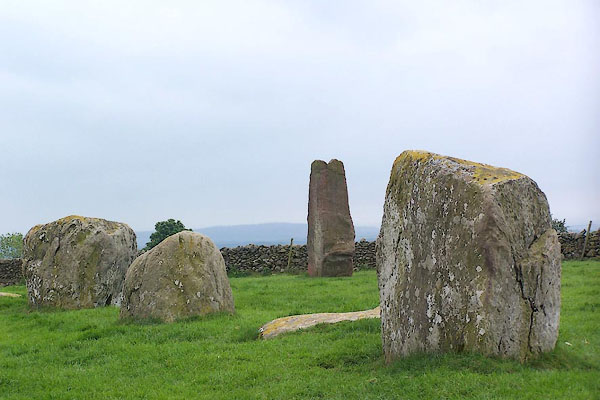
BNT42.jpg (taken 30.5.2007)

Click to enlarge
CGJ93.jpg (taken 19.8.2017)
placename:- Long Meg and her Daughters
 goto source
goto sourcethird page:- "(9) And at Salkelds upon the River Eden, a Monument of seventie seven stones, each of them ten foot high above ground, and one of them at the entrance fifteene, as a Trophie of Victory was erected. These are by the By-dwellers called Long Megge and her daughters."
placename:-
 goto source
goto sourcepage 168:- "... but further to transcend
To these great things of note, which many Countries call
Their wonders, there is not a Tract amongst them all,
Can shew the like to mine, at the lesse Salkeld, neere
To Edens Bank, the like is scarcely any where,
Stones seventie and seven stand, in manner of a Ring,
Each full ten foot in height, but yet the strangest thing,
Their equall distance is, the circle that compose,
Within which other stones lye flat, which doe inclose
The bones of men long dead, (as there the people say;)
..."
placename:- Sakelds Stones
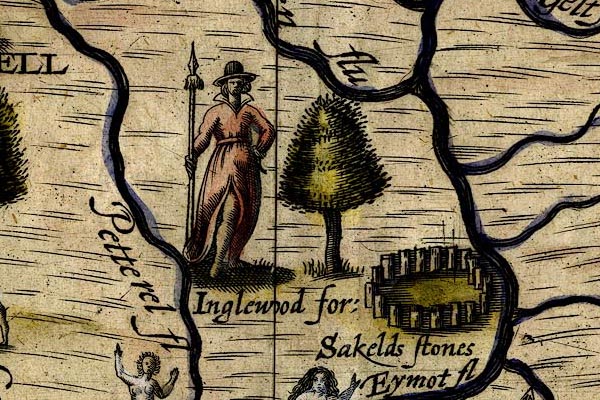
DRY508.jpg
"Sakelds stones"
Ring of 18 standing stones.
item:- JandMN : 168
Image © see bottom of page
placename:- Great Mag and her Sisters
"A mile from Peroth in a low bottom a moorish place stands Great Mag and her Sisters, the story is that these soliciting her to an unlawfull love by an enchantment are turned with her into stone; the stone in the middle which is called Mag is much bigger and have some forme like a statue or figure of a body but the rest are but soe many craggy stones, but they affirme they cannot be counted twice alike as is the story of Stonidge [Stonehenge], but the number of these are not above 30; however what the first design of placeing them there either as a marke of that sort of moorish ground or what else, the thing is not so wonderfull as that of Stonidge, because there is noe such sort of stone in 20 miles off those downs and how they of so vast a bulk and weight should be brought thither, whereas all this country abounds with quarrys of stone and its mostly rocks."
 goto source
goto source"..."
"Salkelds, at the least of which is a Circle of Stones, 77 in Number, each of them 10 Feet high, and before them stands a single one by itself, which is 15 Feet high; this the common People call Long Meg, and the rest her Daughters; and within the Circles are two Heaps of Stones, under which the People suppose there are dead Bodies buried, which Mr. Camden thinks very probably; but he supposes that the great Stones are a Monument to some Victory; but that the Commentator is of Opinion, that the Heap of Stones in the Middle of the Monument are no Part of it; but having been gather'd off the plough'd Lands adjoining, have been thrown together here as in a waste Corner of the Field; and as to the great Stones, he says, they seem to be Monuments erected at the solemn Investiture of some Danish Kings, like Rolrich Stones in Oxfordshire, those of Kongstolen in Denmark, and Mooresteen in Sweden. ..."
 goto source
goto sourceGentleman's Magazine 1752 opp p.311
Print, uncoloured engraving, Long Meg and her Daughters, near Little Salkeld, Hunsonby, Cumberland, published by the Gentleman's Magazine, 1752.
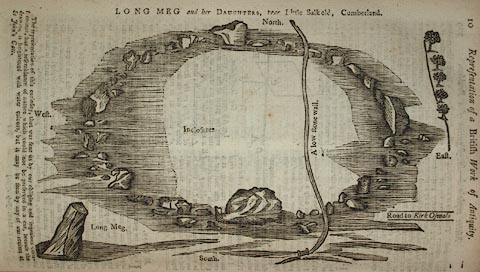 click to enlarge
click to enlargePR0753.jpg
"LONG MEG and her DAUGHTERS, near Little Salkeld, Cumberland."
Size: wxh: 21x12cm.
item:- Armitt Library : Gents Mag 1752.1
Image © see bottom of page
 goto source
goto sourceGentleman's Magazine 1752 p.311 "Wigton July 1712."
"I Went some days ago to examine that curious remain of British antiquities called Long Meg and her Daughters, about which it must be acknowledged all conjectures are extremely uncertain."
"They are situated upon an eminence on the east side of the river Eden, near a mile from it, above a village called Little Salkeld; this eminence appeared to have been all moor formerly, but now about half ye stones are within inclosures, placed in an orbicular form, in some places double. I make 70 principal ones, but there are 1 or 2 more disputable; several lie flat on the surface, their greatest eminence not exceeding a foot, others yet less, and others perpendicular to the horizon; the highest of those in the circular range does not much exceed 3 yards, nor is it more than 4 wide, and 2 deep; but none of them have a regularity of shape, though the constructors seem to have aimed at a parallelopipedon. Long Meg herself is near four yards high, and about 40 yards from the ring, towards the southwest, but leans much, it being of what they call the free-stone kind, is more regular than those in the circle, and is formed like a pyramid on a rhomboidal base, each side being near two yards at the bottom, but a good deal narrower at the top. (What I mean by the base is only the ground plan of the stone itself, for as to what is in architecture called base, it has none but earth). The others in the orbicular range are of no kind of stone to be found in that neighbourhood, and the four facing the cardinal points are by far the largest and most bulky of the whole ring; they contain at least 648 solid feet or about 13 London cartloads, and, unless they are a composition, (which I am much induced to believe) no account can be given what carriages could have brought them there, nor by what means they could be placed erect when they came. It is to be noted that these measures are only what appeared above groound; we have reason to suspect that at last a yard is left in the earth, which will make the whole amount to a prodigious weight more. Others are erect, but not of such enormous size, and others, as I said before, lie flat along, not thrown down, as I think, but so placed either by choice or design, and some of these are also very large. In diameter the ring may be 80 yards or more, and the circle is pretty regular, but how they came there and their destination is the important question."
"I am, Sir, Yours, &c. G.S."
placename:- Long Meg and Her Daughters
"Near to little Salkeld, on the summit of a large hill, a little towards the north, is a large and perfect druidical monument, called by the country people, Long Meg and her Daughters."
item:- Druids
 goto source
goto sourcePennant's Tour 1773, page 164 "... I saw, in the parish of Addingham, the noted Druidical Temple called Long Meg and her daughters. The circle is formed of sixty-seven rude stones placed upright, and of unequal heights: all are placed single ex-"
 goto source
goto sourcePennant's Tour 1773, page 165 "[ex]cept near the entrance, where there are two stones placed without, opposite to the two which form the entrance and part of the circle. Long Meg, as the tallest stone is called, stands sixty-one feet west from the portal, and just opposite to it: it is eighteen feet high, and fourteen in its greatest girth; is composed of red grit stone, as the others are of granite, lime, and free-stone. The area of the circle was covered with corn, so I must borrow its diameter from Mr. Hutchinson, who informs us it is of three hundred feet."
"I refer the curious reader to the learned Borlase for an account of the uses of these circles. Whether this was designed for religious purposes, for national assemblies, for election of Princes, or for the celebration of games, as certain circles in Caernarvonshire are reasonable supposed to be, I cannot possibly determine. Nothing is left on which to found a conjecture. It might have stood in a scared grove of oaks, the shade of which added solemnity to the rites, were they religious: were they political, the people might have stood without the circle of stones, prohibiting a nearer approach to the vulgar; if the former, the Arch-Druid might have stood near the lofty stone of distinction, his entrance through the portal might be preceded by an"
 goto source
goto sourcePennant's Tour 1773, page 166 "awful procession, and sacrifices and all the fourberie of priestcraft be performed in the centre of the area within sight of the trembling crowd."
placename:- Long Megg and her Daughters
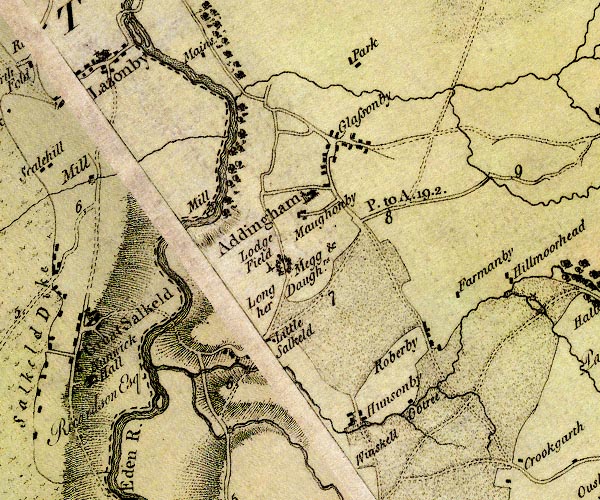
D4NY53NE.jpg
"Long Megg &her Daughrs."
circle of stones and standing stone to W
item:- Carlisle Library : Map 2
Image © Carlisle Library
 goto source
goto sourcePage 171:- "... At Little-Salkeld is the largest druidical circle in the northern parts. ..."
placename:- Long Megg
 goto source
goto sourcePage 174:- "..."
"... Salkelds. At the lesser stands a kind of circle of 77 stones, each ten feet high, and before them at the entrance a single one 15 feet high. The common people hereabouts call this Long Megg, and the rest her daughters, and within the circle are two heaps of stones, under which they say the bodies of the slain were buried. And indeed it is probable enough that this is a monument of some victory."
placename:- Long Meg and Her Daughters
 goto source
goto sourcePage 190:- "..."
"Long Meg and her daughters, in Addingham parish, q.d. Ald Hengham, a town at the old hanging stones, is a druidical circle, 300 feet diameter, of 100 stones, of which 67 are now standing. At the south side 15 paces south-west at the distance of 70 feet or 40 yards is an upright squarish stone near 15 feet in girth, and 12 high, and near two yards square at bottom and hollow at top like a Roman altar, one of its angles turned to the circle, and each angle answering to a cardinal point, and near it next the circle four large stones, or as Stukeley three, forming an altar or sacellum, and two towards the east, west, and north. In the middle of the circle are two round plots of ground, of a different colour from the rest, and more stony and barren. ..."
placename:- Long Meg and Her Daughters
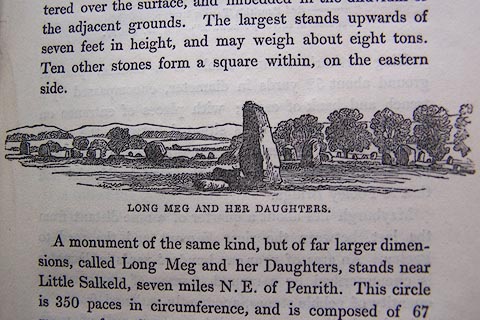 click to enlarge
click to enlargeO80E19.jpg
item:- Armitt Library : A1180.20
Image © see bottom of page
 goto source
goto sourcePage 81:- "..."
"A monument of the same kind [as Castlerigg Stone Circle], but of far larger dimensions, called Long Meg and her Daughters,"
 goto source
goto sourcePage 82:- "stands near Little Salkeld, seven miles N.E. of Penrith. This circle is 350 paces in circumference, and is composed of 67 massy unformed stones, many of them ten feet in height. At seventeen paces from the southern side of the circle, stands Long Meg - a square unhewn column of red freestone, near 15 feet in girth, and 18 feet high."
placename:- Long Meg and Her Daughters
 goto source
goto sourcePage 29:- "... on a black moor, ... our eyes are greeted with the sight of"
"LONG MEG AND HER DAUGHTERS."
"'A weight of awe not easy to be borne,
Fell suddenly upon my spirit, cast
From the dread bosom of the unknown past,
When first I saw that sisterhood forlorn:
And her, whose strength and stature seem to scorn
The power of years - pre-eminent, and placed
Apart to overlook the circle vast.'"
"The road passes through the midst of the circle, as also does a wall, forming the boundary of the common, thus injuring the effect of this mighty monument of British superstition. The stones, sixty-six in number, are of various sizes, some lying hid amidst the herbage, others standing erect, and forming a circle three hundred and fifty paces in circumference. On the south side, without the circle, stands Long Meg, a large upright stone, about fifteen feet round, and eighteen feet high, of unhewn freestone, which seems to have been brought from Lazonby Moor, all the rest being a kind of"
 goto source
goto sourcePage 130:- "whinstone. Within the circle, near Long Meg, four of them form a square; and towards the east, west, and north, two stones of greater magnitude are placed at a much wider distance than the rest. ..."
 goto source
goto sourcePage 175:- "... a druidical monument called 'Long Meg and her Daughters,' consisting of one very high"
 goto source
goto sourcePage 176:- "stone, and about sixty others, forming a circle, the property of Colonel Lacy of Eden Lacy;"
item:- counting a stone circle; treasure
 goto source
goto sourcePage 96:- "... [country people] still hold to the notion that nobody can count the druid stones correctly; and also that a treasure is buried under the largest stone. ... We ourselves counted Long Meg and her daughters, near Penrith, many times before making out the prescribed sixty-seven, with any certainty. As for the treasure, can any one prove that it is not there? ..."
"..."
 goto source
goto sourcePage 170:- "... The circle called Long Meg and her daughters is six miles from Penrith; and no relic of the kind in England is better worth a visit. ..."
 goto source
goto sourceGentleman's Magazine 1868 part 1 p314.
page 308:- "NOTES ON STONE CIRCLES. / BY J. T. BLIGHT, F.S.A."
"... ..."
The article, pp.308 to 319, has some idiosyncratic ideas about stone circles, mostly in Cornwall, and, page 314:- "... ..."
"... there are many circles whose diameters are so great that it cannot be conceived that there ever existed within them mounds so vast as to occupy all the enclosed space. These larger circles should rather be regarded as great enclosing outworks for the protection of a group of barrows, or lesser circles, as was probably the case with Long Meg and her Daughters in Cumberland, ..."
"... ..."
MSN1P026.txt
Page 26:- "..."
"... More interesting remains still are those of three Druid temples, which are circles formed of huge blocks of stone planted upright in the ground; the largest of these stone circles, called "Long Meg and her Daughters," is near Penrith. "Long Meg" is a lady some six yards high."
placename:- Long Meg and her daughters
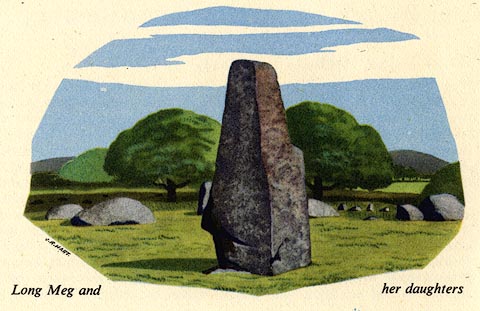 click to enlarge
click to enlargeDP01E5.jpg
item:- JandMN : 188
Image © see bottom of page
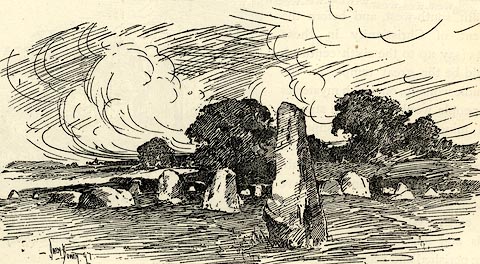 click to enlarge
click to enlargeBGG121.jpg
Included on p.66 of Lakeland and Ribblesdale, by Edmund Bogg.
item:- JandMN : 231.21
Image © see bottom of page
 click to enlarge
click to enlargePR0307.jpg
Illustrations of place visited by the Royal Archaeological Institute.
item:- Dove Cottage : 2008.107.307
Image © see bottom of page
placename:- Long Meg and Her Daughters
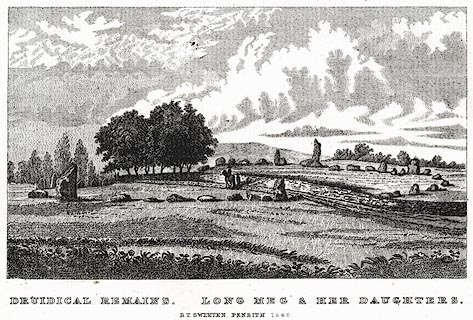 click to enlarge
click to enlargePR0429.jpg
printed at bottom:- "DRUIDICAL REMAINS. LONG MEG &HER DAUGHTERS. / B T SWEETEN PENRITH 1848"
item:- Dove Cottage : 2008.107.422
Image © see bottom of page
 click to enlarge
click to enlargeBMZ01.jpg
item:- Dove Cottage : Lowther.56
Image © see bottom of page
placename:- Long Meg and Her Daughters
 click to enlarge
click to enlargePR0753.jpg
Tipped in opposite p.311 in the Gentleman's Magazine vol.22, 1752.
There is accompanying text p.311:- "'Wigton July 1712.'"
"'I Went some days ago to examine tha curious remain of British antiquities called Long Meg and her Daughters, about which it must be acknowledged all conjectures are extremely uncertain.'"
"'They are situated upon an eminence on the east side of the river Eden, near a mile from it, above a village called Little Salkeld; this eminence appeared to have been all moor formerly, but now about half ye stones are within inclosures, placed in an orbicular form, in some places double. I make 70 principal ones, but there are 1 or 2 more disputable; several lie flat on the surface, their greatest eminence not exceeding a foot, others yet less, and others perpendicular to the horizon; the highest of those in the circular range does not much exceed 3 yards, nor is it more than 4 wide, and 2 deep; but none of them have a regularity of shape, though the constructors seem to have aimed at a parallelopipedon. Long Meg herself is near four yards high, and about 40 yards from the ring, towards the southwest, but leans much, it being of what they call the free-stone kind, is more regular than those in the circle, and is formed like a pyramid on a rhomboidal base, each side being near two yards at the bottom, but a good deal narrower at the top. (What I mean by the base is only the ground plan of the stone itself, for as to what is in architecture called base, it has none but earth). The others in the orbicular range are of no kind of stone to be found in that neighbourhood, and the four facing the cardinal points are by far the largest and most bulky of the whole ring; they contain at least 648 solid feet or about 13 London cartloads, and, unless they are a composition, (which I am much induced to believe) no account can be given what carriages could have brought them there, nor by what means they could be placed erect when they came. It is to be noted that these measures are only what appeared above groound; we have reason to suspect that at last a yard is sleft in the earth, wch will make the whole amount to a prodigious weight more. Others are erect, but not of such enormous size, and others, as I said before, lie flat along, not thrown down, as I think, but so placed either by choice or design, and some of these are also very large. In diameter the ring may be 80 yards or more, and the circle is pretty regular, but how they came there and their destination is the important question.'"
"'I am, Sir, Yours, &c. G.S.'"
printed at top:- "LONG MEG and her DAUGHTERS, near Little Salkeld, Cumberland."
GS is George Smith.
item:- Armitt Library : A5735 : 8
Image © see bottom of page
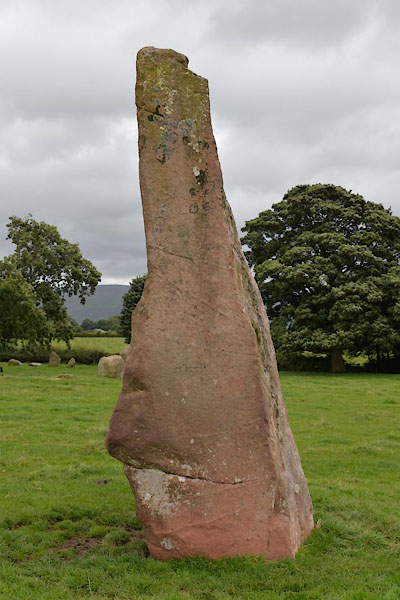
CGJ95.jpg Long Meg, menhir.
(taken 19.8.2017)
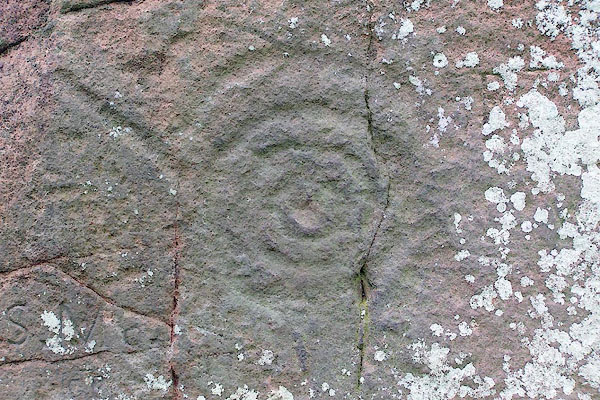
BNT39.jpg Cup and ring mark on Long Meg.
(taken 30.5.2007)
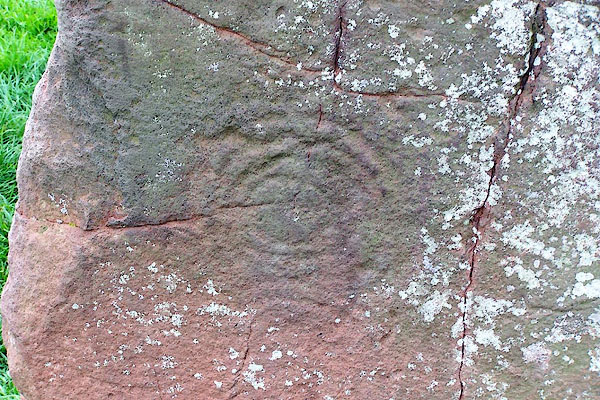
BNT40.jpg Cup and ring mark on Long Meg.
(taken 30.5.2007)

BNT43.jpg (taken 30.5.2007)

Click to enlarge
BNT38.jpg (taken 30.5.2007)
Waterhouse, John: 1985: Stone Circles of Cumbria: Phillimore and Co (Chichester, Sussex):: ISBN 0 85033 566 3
Burl, H A W: 1976: Stone Circles of the British Isles: Yale University Press (United States)
Stukeley, William: 1776: Iterarium Curiosum: (London): vol.2: p.48
